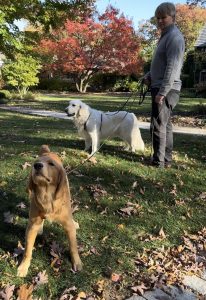I was born with two different sized legs. The bone and muscle mass, among other things, in my left leg is about a third less than my right. I was also born with a left foot that was turned-out. A cast was put on my left baby leg to rotate my knee in so my foot wouldn’t be turned-out. So, my left knee is now turned-in. My left foot measures US men’s five and a half, my right measures ten and a half. What does this have to do with dogs and a social walk? Indulge me for a moment.
We Are All Different
As a kid, I soon found I couldn’t walk as far in the same amount of time as anyone else I knew. I tried to keep up, compelling myself to walk faster than what was good for me. I experienced separation stress, as people I was with walked faster than I could. There were times, as a child, when I cried as the people I was with walked along at their normal pace. Separation stress, and the want to fit in, compelled me to endure the physical pain to keep up. I developed a high threshold for pain, and fooled myself into thinking my body was able to keep up. I played sports. Hockey was my favorite. I enjoyed the speed a blade of steel on ice could afford. Down hill skiing was also a sport I enjoyed, as it allowed gravity to generate the speed my muscles couldn’t. As with walking, skating and skiing with others compelled me to go faster than my body could, or should. I experienced countless injuries.
Pooh Bear
It wasn’t until well into adulthood when I realized I needed to go at the pace at which is best for me. My family calls me Pooh Bear. They think I’m drifting back in contemplation of my surroundings, which is partly true. Funny the things we miss when we go fast. Slowing down is maybe one of the best things
I’ve ever done for myself, mentally physically and emotionally.
A Social Walk
A Social Walk is only a social walk if whomever is walking walks together. The pace at which we walk depends on who we are walking with. A walk is a walk; not a trot, canter, or gallop. When I see a dog trotting, I wonder why. Could it be the dog is keeping up, so they’re not left behind, left alone. Is it because they’re on a leash and have gotten pulled when they stop, so they no longer stop. Even with my left leg the way it is, and even with the longest legged dog, I find I need to go at about the pace I should have been going all along. It’s in large part thanks to dogs that I caught myself. When I’m with people and a dog, I often take the dog and let the people go ahead. We catch up, or not. If we don’t get wherever the people got, they eventually come back. We might turn back with them. If we do, we drift behind as we did before. People often feel sorry for us having missed out on whatever they got to. Funny thing is we got to things they missed.
Pooh Bear and the Dog.

Reflections on Social Walking vs. Regular Dog Walking
I’ve been working in the dog walking industry since 1992. There was a time when I thought the more and faster I walked the better for the dog. It took me a while to realize, for myself and others: everyone has a different pace, and there is such a thing as too much walking. There’s social and there’s walking. A social walk can be a great thing, and it can be painful. Separation stress or physical pain caused by keeping up. Often, pain is tolerated over being left behind. Look to listen. Look at your dog. Ask yourself: how much and at what pace should I walk to be with my dog, for my dog? When I arrive for a dog walk, I often find the answer is zero. The dog has already had too much walking. So, we don’t walk. We might stand, we might sit, and watch the world wag. I go by the dog. They let me know.
About the Author:
Lennox Armstrong is an International Dog Trainer School (IDTS) certified Dog Trainer, Calming Signals and Dog Behavior Specialist through the Nordic Education Centre for Ethical Dog Training. His primary professional focus is educating himself and others about how to take care of canines.


